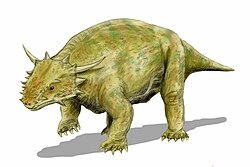| Procolophonids Temporal range: Middle Permian - Late Triassic | |
|---|---|
 | |
 | |
| Skeleton (top) and life restoration (bottom) of Kapes bentoni (Procolophoninae) scale bar = 1cm | |
| Scientific classification | |
| Kingdom: | Animalia |
| Phylum: | Chordata |
| Class: | Reptilia |
| Subclass: | † Parareptilia |
| Order: | † Procolophonomorpha |
| Superfamily: | † Procolophonoidea |
| Family: | † Procolophonidae Seeley, 1888 |
| Subgroups and Genera | |
| |
| Synonyms | |

Procolophonidae is an extinct family of small, lizard-like procolophonian "parareptiles" known from the Late Permian to Late Triassic that were distributed across Pangaea, having been reported from Europe, North America, China, South Africa, South America, Antarctica and Australia. The most primitive procolophonids were likely insectivorous or omnivorous, more derived members of the clade developed bicusped molars, and were likely herbivorous feeding on high fiber vegetation or durophagous omnivores. [3] Many members of the group are noted for spines projecting from the quadratojugal bone of the skull, which likely served a defensive purpose as well as possibly also for display. [4] At least some taxa were likely fossorial burrowers. [5] While diverse during the Early and Middle Triassic, they had very low diversity during the Late Triassic, and were extinct by the beginning of the Jurassic. [6]

